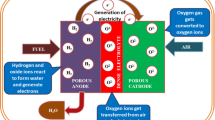Abstract
An organized analysis of a metal oxide (BaTiO3) synthesized via solid-state reaction coated on FTO (fluorine-doped tin oxide) substrate for multiple applications is attentively done. The dominant characteristic (110) peak plane authenticates the tetragonal structure formation (structural properties). The bandgap calculated (tauc’s plot) from the absorbance spectrum is 3.2 eV. The experimental evaluation of the fabricated gas sensor was done using a gas sensing setup for the toxic gases with carbon monoxide (CO) and methane (CH4). The response time (~1.86 s (5 ppm), 2.74 s (~10 ppm)) and the recovery time (~8.68 s (5 ppm), ~5.23 s (10 ppm)) under CO were found to be better compared with CH4. The fabricated gas sensor showed ~11.5% (5 ppm) and ~16.2% (10 ppm) of sensor response to CO gas, higher than CH4. In addition, the fabricated sensor’s performance is extended to acceleration application. An output voltage of ~1.16 V at a resonant frequency of 10 Hz is obtained. The fabricated BaTiO3 sensor is used to explore multifunctional sensing properties, i.e., to detect and sense toxic gases (CO and CH4), and acceleration of both of these sensing properties work well together for the mine industry. Only a few literature use BaTiO3 for multifunctional sensing applications.



Similar content being viewed by others
References
Ramany K, Shankararajan R, Savarimuthu K, Venkatachalapathi S, Gunasekaran I and Rajamanickam G 2022 Nanotechnology 33 035713
Ramany K, Shankararajan R, Savarimuthu K, Gunasekaran I, Rajamanickam G and Narendhiran S 2020 IEEE Trans. Nanotechnol. 19 728
Ren P, Lingling K Q and Shi Q 2022 Nanomaterials 12 228
Sertel B C, Efkere H I and Ozcelik S 2020 IEEE Sens. J. 20 13436
Simion C E, Ghica C, Mihalcea C G, Ghica D, Mercioniu I and Somacescu S 2021 Chemosensors 9 224
Steinhauer S, Brunet E, Maier T, Mutinati G C, Kock A and Freudenberg O 2013 Sens. Actuators B Chem. 187 50
Alia H M, Shokr E K, Taya Y A, Elkot S A, Hasaneen M F and Mohamed W S 2022 Sens. Actuators A Phys. 335 113355
Dutta D P, Roy M, Maiti N and Tyagi A K 2016 Phys. Chem. Chem. Phys. 18 9758
Patil R P, More P V, Jain G H, Khanna P K and Gaikwad V B 2017 Vacuum 146 455
Singh M, Yadav B C, Ranjan A, Kaur M and Gupta S K 2017 Sens. Actuators B Chem. 241 1170
Vijatovic Petrovic M M, Radojkovic A, Bobic J D, Dzunuzovic A, Llic N and Stojanovic B D 2019 J. Mater. Sci. 54 6038
Koka A and Sodano H A 2013 Nat. Commun. 4 2682
Kosa A, Zhou Z, Tang H and Sodano H 2014 Nanotechnology 25 375603
Baby Sreeja S D, Gopalan S and Sreekala C O 2020 Mater. Today Proc. 05 042 2214
Kappadan S, Gebreab T W, Thomas S and Kalarikkal N 2016 Mater. Sci. Semicond. Process 51 42
Alshoaibi A, Saber O and Ahmed F 2021 Crystals 11 550
Park K and Seo Gas D J 2003 Mater. Chem. Phys. 85 47
Hjiri M, Bahanan F, Aida M S, El Mir L and Neri G 2020 J. Inorg. Organomet. Polym. Matter 30 4063
Ji H, Zeng W and Li Y 2019 Nanoscale 11 22664
Kim J-H, Mirzaei A, Kim H W and Kim S S 2018 Sens. Actuators B Chem. 267 597
Gong H, Hu J Q, Wang J H, Ong C H and Zhu F R 2006 Sens. Actuators B Chem. 115 247
Arsat R, Breedon M, Shafiei M, Spizziri P G, Gilje S and Kaner R B 2009 Chem. Phys. Lett. 467 344
Wu Q-H, Li J and Son S-L 2010 Curr. NanoSci. 6 525
Xue D, Wang P, Zhang Z and Wang Y 2019 Sens. Actuators B Chem. 296 126710
Han L, Zhang S, Shang B, Zhang B, Wang Y and Bala H 2021 Front. Mater. Sci. 1 1
Maffeıs T G G, Owen G T, Penny M W, Starke T K H, Clark S A and Ferkel H 2002 Surf. Sci. 20 29
Hamedani N F, Mahjoub A R, Khodadadi A A and Mortazavi Y 2011 Sens. Actuators B Chem. 156 737
Author information
Authors and Affiliations
Corresponding author
Rights and permissions
About this article
Cite this article
Binowesley, R., Savarimuthu, K., Shankararajan, R. et al. Experimental performance evaluation of non-toxic metal oxide synthesized via solid-state reaction for room temperature-sensing applications. Bull Mater Sci 46, 144 (2023). https://doi.org/10.1007/s12034-023-02988-2
Received:
Accepted:
Published:
DOI: https://doi.org/10.1007/s12034-023-02988-2




